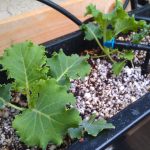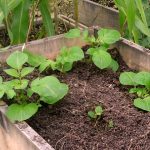Winter Gardens
 You don’t have to wait until spring to have a healthy and productive garden. The weather in your area might actually be perfect for leafy greens, root crops, and herbs.
You don’t have to wait until spring to have a healthy and productive garden. The weather in your area might actually be perfect for leafy greens, root crops, and herbs.
Kale, Cabbage, Collard Greens, Carrots, Beets, Radish, Turnips, Kohlibri, Swiss Chard, Parsely, Spinach, and various herbs all have a place in a winter garden.
If you live in a warmer climate it is possible to grow potatoes in raised planter beds. The raised beds, tote boxes, or even tires, as well as planting mediums like straw provide some insulation, and allow potatoes to thrive through cold spells.
Our winter gardens are often a combination of leafy greens, root crops, potato boxes, and whatever we can continue to produce beyond fall. We are fortunate enough, within our microclimate in Southern California, to produce both tomatoes and corn into December.
 In some zones it may be unrealistic to produce anything outdoors very well. Of course there are hydroponics and indoor growing alternatives, and mini-greenhouses, but it could just be a great opportunity to fix nitrogen with a cover crop or let fall leaves compost and enrich your soil.
In some zones it may be unrealistic to produce anything outdoors very well. Of course there are hydroponics and indoor growing alternatives, and mini-greenhouses, but it could just be a great opportunity to fix nitrogen with a cover crop or let fall leaves compost and enrich your soil.
If you waited until December to take action on a cover crop, you may be too late. You could try and get a late start on Field Peas, Winter Wheat, Ryegrass, Oats, or Clover, but you may not get them going as you might have in September, October, or even November.
If you get your winter cover crop growing, be sure to mow down or top plants before they go to seed, or you will end up competing with your cover crops as they germinate in spring. We till our soil, and try and let the soil sit for at least a week before planting or sowing seed.
While there are some proponents of no-till techniques that you can experiment with, we have always had great success tilling cover crops and fall compost into our soil, so we are sticking to it.
Tags: Organic, vegetables, winter garden Comments
Leave a Reply